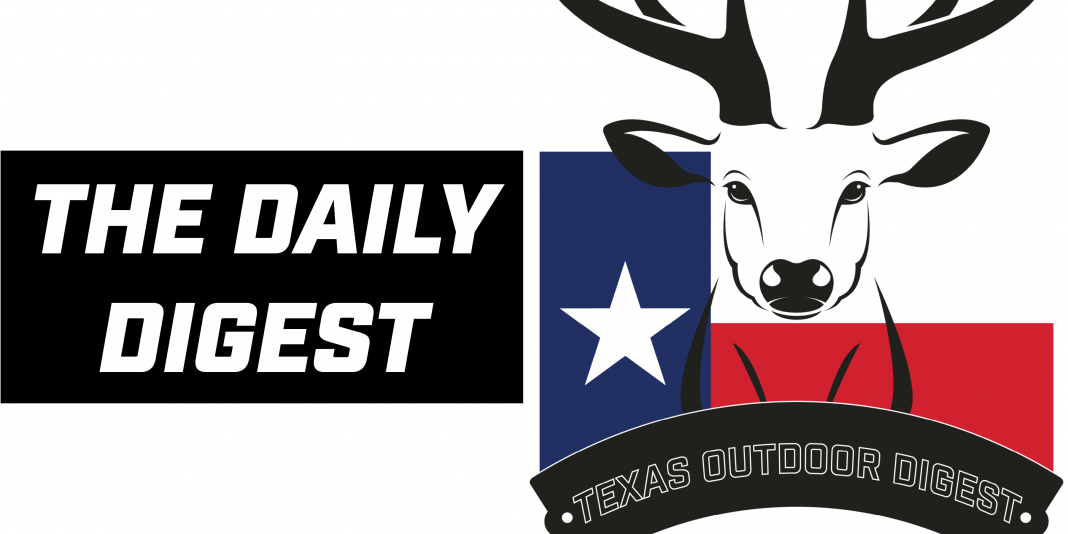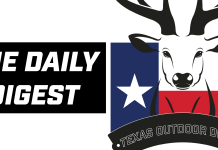The Daily Texas Outdoor Digest is sent to your inbox to keep you up to date about hunting, fishing, conservation and outdoors pursuits making headlines and going viral in the Lone Star State and beyond. It’s free, so subscribe today!
Here’s what’s worth reading today, Friday, April 9, 2021:
Chronic wasting disease found at Texas deer breeding facilities near Metroplex, Uvalde
Texas spring hunting pursuits bring out critters that bite back
How California snared two elite hunters posting ‘once a lifetime’ kills on social media
Joe Frater and Chris Stone were on their way to social media stardom in the elite world of trophy deer hunting. The two law enforcement officers — Frater is a corrections officer at a local prison; Stone is an investigator for the Amador County district attorney — regularly showed off their trophies from just a few years of hunting with bows and arrows in the Sierra foothills of Northern California.
They posed with impressive, mature bucks that they somehow managed to pull from a place known mostly for its scrawny deer with tiny racks. The men appeared on hunting websites, podcasts and YouTube videos, and they had sponsorships with companies that sell hunting equipment.
Along the way, California wildlife officers were beginning to grow skeptical of the steady feed of social media posts featuring Frater and Stone. Most of their kills looked like the bruisers that celebrity hunters brag about on hunting shows — that is, extraordinary.
What unfolded next over five months in 2019 could be an episode of “CSI,” as wardens undertook a complex operation with covert stakeouts, DNA evidence, aerial surveillance and vehicle tracking devices — tactics that the men’s attorneys say went too far in upholding California’s stringent and complex hunting rules.
From the beginning, investigators thought the two archery hunters may have been cheating. They suspected Frater and Stone had lured in the deer using bait, a practice that’s considered unsporting. It’s also illegal in California.
“The caliber/type of deer is very rare for a legal CA hunter to harvest, especially with only using archery equipment,” Game Warden David Moskat wrote in a 2019 search warrant. “I have known many archery and rifle hunters who would be satisfied to harvest even one of this caliber of buck in a lifetime of legal hunting in California.”
The designer hunting Florida’s Burmese pythons to make clothes
With the state employing hunters to reduce the population, former Yeezy assistant Elle Barbeito went back to her roots to craft snake-skin fashion in the Everglades.
The Burmese python, a snake native to Southeast Asia and currently undulating rapidly across the Florida Everglades, is beautiful – objectively, unsentimentally beautiful. Close your eyes and imagine any snake at all: even if you’ve never seen one in person, the Burmese python likely occupies your imagination – it’s an archetypal snake, graceful and massive, blazoned with oil-smooth markings that form terraneous patterns, like dark map lines or puzzle pieces. One of the world’s largest snakes, Burmese pythons grow long – up to 23 feet – and wide; in the humidity of the Everglades, a climate not unlike their countries of origin, they have no real predators, not even the Florida gator.
Much wildlife can adapt happily and safely to new environments, and using terms like “non-native” and “invasive” around introduced flora and fauna can be dangerous, militarized, and inaccurate. That said, Florida has more introduced species, particularly reptiles, than any other state, due in part to pet-owners (in February, the state’s Fish and Wildlife Conservation Commission, aka FWC, banned the possession and breeding of certain non-native reptiles for their adverse effects on local habitats).
The Burmese python might be the most infamous. As Florida endures the effects of climate change – rising temperatures, decreasing biodiversity, seawater creeping through the state’s porous limestone bedrock – the python thrives, moving northerly. Studies are conflicting: some argue that Burmese pythons are unable to survive the cold snaps north of South Florida; others find some can adapt, quickly. They remain enigmatic and easily camouflaged, their precise population unknown. Through agencies like the South Florida’s Water Management District (SFWMD) and the FWC – and more volunteer independent projects, like the Swamp Apes – hunters are employed to slowly eradicate the population.
“The first time we went to the Everglades during the day,” says Elle Barbeito. “It was so beautiful, so quiet. The air just felt better. I expected to feel more scared because the experience is intense, but it was a moment of great excitement and curiosity. I had never seen the Everglades in that light. I felt extremely lucky to be able to interact with the snakes in this way, and grateful they were there to help me create and make the things I do.”
Dak Goes Fishing On #TeammateThursday
Thursdays are no longer just for #TBT pictures, but rather teammate bonding. Last Thursday, Dallas Cowboys quarterback Dak Prescott invited offensive tackle La’el Collins out for a day on the water.
Prescott and Collins, who have been teammates for five years, were joined by country singers Chris Young and Jimmie Allen, as well as Prescott’s brother Tad. The crew spent the day playing music, catching fish and enjoying the Bayou’s good weather.
Managed Lands Deer Program enrollment is now open for 2021-22 season
Enrollment in the Managed Lands Deer Program (MLDP) is now open for the 2021-22 hunting season. Open enrollment for the MLDP Conservation Option runs from April 5 through June 15 this year while the Harvest Option opens May 1 and runs through Sept. 1. New this year, fees are being charged for each enrollment option. Enrollments and fee payments can all be made through Texas Parks and Wildlife Department’s Land Management Assistance online system.
The Land Management Assistance online system will require landowners hoping to enroll to create an account and draw a property boundary. An email address is required for the landowner and any designated agents the landowner may assign to the account.
MLDP is a program intended to foster and support sound management and stewardship of native wildlife and wildlife habitats on private lands in Texas. Deer harvest is an important aspect of habitat management and conservation. Landowners enrolled in either the MLDP Harvest Option or Conservation Option can take advantage of extended season lengths and property-specific customized harvest opportunities.
The Harvest Option is an automated, ’do-it-yourself’ option for MLDP participation that provides landowners with a deer harvest recommendation, tag issuance and general guidance about wildlife and wildlife habitat management. Participation in the Harvest Option does not require habitat management practices, deer population data or the participant to work directly with a TPWD wildlife biologist.
The Conservation Option offers program participants the opportunity to work with a TPWD biologist to receive customized, ranch-specific habitat and deer harvest recommendations and MLDP tag issuance for white-tailed deer and/or mule deer. This option does require the reporting of certain types of deer data as well as completion of specific habitat management practices each year to participate and remain in the program.
MLDP participation is completely voluntary. Once enrolled, program participants must meet MLDP requirements for the full year of enrollment.
The hunt for the new world-record archery elk
Back when world-record elk holder Shawn O’Shea guided whitetail hunters for his neighbor in central Alberta, he earned the nickname “Shamrock” for his ability to find big bucks for clients.
“With my name and my success, guys just figured I was lucky,” says O’Shea, who farms and ranches east of Edmonton in the part of the province where rolling grain fields transition to the bush, the local term for the fingers of aspen and poplar that dominate the landscape as you go north. “I’ve taken some nice animals over the years, but to my testament, I probably hunt and think about hunting 100 times more than anybody I know. When I watch TV, it’s about hunting. When I read, it’s about hunting. When I go to church, I’m praying for my family and for the chance to kill bigger bucks and bulls.”
O’Shea’s benedictions must have been received, because the 55-year-old Albertan holds the new world record for non-typical elk. The 449 4/8-inch bull, shot in September on land O’Shea has hunted since he was a boy, has been certified by the Pope and Young Club as the largest non-typical elk ever taken by a bowhunter.
But tagging that elk was the product of anything but luck. Instead, O’Shea’s harvest of the 9×9 bull with crowns of nontypical points is the result of generations of his family living on productive land, learning how to hunt it, and days and hours spent in the presence of the elk herd that produced the remarkable specimen.
“I guess you can say we’ve had a long-term relationship with those elk,” says O’Shea, whose achievement will be officially recognized by Pope & Young at its July convention in Reno, Nevada. “I know every square inch of that area because I’ve hunted it for my lifetime. I’ve been hunting it so long that I can remember the first time I saw elk show up,” more than 30 years ago.
Yellowstone bison migration minimal; hunter kills down, trapping paused
Fewer bison migrated out of Yellowstone National Park this winter, reducing the hunter harvest to almost 170 animals, according to numbers compiled by Montana Fish, Wildlife & Parks.
Last year, hunters killed more than 200 bison with another 260 shipped to slaughter. Because so few bison were available to hunters this season, the park’s staff decided not to capture any for its Bison Conservation Transfer or slaughter programs, despite agreeing to a recommended culling quota of 500 to 700 animals last year. As a result, the herd could grow to 5,100 to 5,200 animals by the end of the summer, close to the 10-year average, the park’s bison biologist, Chris Geremia, predicted.
“This has been an interesting year to see what happens if we only rely on hunting” as a means to control the bison population, said Cam Sholly, superintendent of Yellowstone, during a Thursday online meeting of the Interagency Bison Management Plan. “It kind of proves the point that we may not be able to rely on any single mechanism from a population management standpoint.”
The park and its partners are discussing how best to fulfill tribal treaty rights for bison while also reducing Yellowstone’s publicly unpopular capture and slaughter program – an outgrowth of a lawsuit settlement with the state of Montana to reduce the bison population – in favor of more capture for quarantine and eventual transfer of live bison to tribes.
It’s a difficult process Sholly referred to as “threading the needle.”
“Ultimately, I would like us to get to the point where we substantially reduced or eliminated how many bison get consigned to slaughter each year,” he said.
Other Fishing, Hunting & Outdoor Pursuits That Might Tickle Your Fancy
Stay in the Know With the Daily Texas Outdoor Digest
If you haven’t subscribed yet, there’s no better time than right now (We hate spam and we won’t share your information with anyone. That’s just not cool):



















